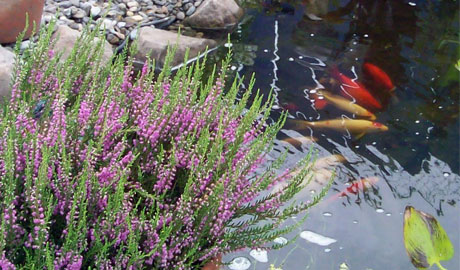Watergarden, Secrets for Clear Water

The Secrets Of Clear Water
Relaxing by cool clear shimmering water, watching fish swimming lazily about and drinking in the serene beauty of water lilies, these are the joys of water gardening. One stumbling block to enjoying a pond is how to get the that water to clear up. It is deceptively easy; all you need to do is add the proper ingredients, keep the filter cleaned and let the pond do all the work.
First, we must distinguish between the two basic types of algae. The moss-like algae which grows on the sides of the pond is actually desirable and is not a type which clouds the water. To prevent excessive growth of this algae, scavenger, such as snails, can be used to graze it. The unicellular type of algae is the culprit of “pea soup” green or cloudy water.
Now for the ingredients; they are: patience, plant, scavengers and a filter system (optional). The most important factor is patience. A new pond (or one just cleaned) will turn cloudy and have some algae. DO NOT DRAIN the pond. The water must age and the micro-organism and plant population must establish themselves. An algaecide can be used during this period to keep the algae growth under control. Remember an algaecide only acts on existing algae and treatment will not keep a pond clear indefinitely. It is a temporary control and will not change conditions in the pond causing algae.
Plants are the secret to clearing up a pond and keeping it clear. They stave the algae by absorbing the carbon dioxide and mineral salts essential for algae to grow. The submerged grasses are especially effective in controlling algae. Water lilies are helpful because their pads shade out a good bit of sunlight. A good rule of thumb for stocking submerged grasses is to stock one bunch of grasses per 1 –2 square foot of pond. Several bunches can be potted together. Water lily pads should cover 50 – 60 % of the surface of the water.
Scavengers, in addition to grazing hair-like algae will also eat leftover fish food. This is important because fish will not eat leftover food. Feed fish only what they will eat in 5 – 10 minutes. Leftover fish food will rot and foul the water.
Careful selection of natural materials mentioned above can lead to a clear pond. However a filter system is a great time-saver in clearing a pond and keeping it clear. Filters remove algae, fish wastes, and any particulate matter clouding a pond. Because a filter is so efficient in removing matter from the pond, the pond is less likely to become cloudy.
Sometimes a clear pond will become cloudy. Several factors can determine this, for example, an overfeeding or drastic weather changes have occurred. During the spring and fall especially, the plants are not as active and algae can take over.
